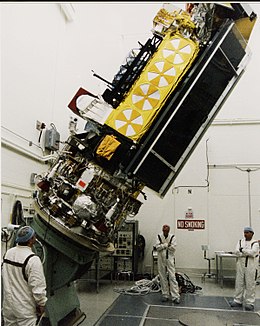NOAA-16

NOAA-16 before launch
|
|
| Mission type | Weather satellite |
|---|---|
| Operator | NOAA |
| COSPAR ID | 2000-055A |
| SATCAT № | 26536 |
| Mission duration | 2 years planned 14 years achieved |
| Spacecraft properties | |
| Spacecraft type | TIROS-N |
| Manufacturer | Lockheed Martin |
| Launch mass | 1,457 kilograms (3,212 lb) |
| Power | 830 watts |
| Start of mission | |
| Launch date | 21 September 2000, 10:22 UTC |
| Rocket | Titan II(23)G Star-37XFP-ISS |
| Launch site | Vandenberg SLC-4W |
| End of mission | |
| Disposal | Decommissioned |
| Deactivated | 9 June 2014 |
| Orbital parameters | |
| Reference system | Geocentric |
| Regime | Sun-synchronous |
| Semi-major axis | 7,226.86 kilometers (4,490.56 mi) |
| Eccentricity | 0.0009525 |
| Perigee | 848 kilometers (527 mi) |
| Apogee | 862 kilometers (536 mi) |
| Inclination | 98.96 degrees |
| Period | 101.91 minutes |
| Epoch | 24 January 2015, 11:59:04 UTC |
NOAA-16, designated NOAA-L before launch, is one of the NASA-provided TIROS series of weather forecasting satellites operated by NOAA.
It was launched on 21 September 2000, in a sun-synchronous orbit, 849 km above the Earth, orbiting every 102 minutes. It hosts the AMSU, AVHRR and High Resolution Infrared Radiation Sounder (HIRS) instruments' APT transmitter. NOAA-16 has the same suite of instruments as carried by NOAA-15 plus an SBUV/2 instrument as well.
NOAA-16's APT has been inoperable due to sensor degradation since November 15, 2000, and High Resolution Picture Transmission has been via STX-1 (1698 MHz) since November 9, 2010.
NOAA-16 was decommissioned on 9 June 2014 after a critical anomaly. On 25 November 2015, at 08:16, the JSpOC identified a possible breakup of NOAA 16 (#26536). All associated objects have been added to conjunction assessment screenings, and satellite operators will be notified of close approaches between the debris and active satellites. The JSpOC catalogs the debris objects when sufficient data is available. As of 26 March 2016, 275 pieces of debris were being tracked.
...
Wikipedia
